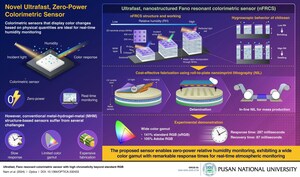Pusan National University Study "Cracks" Mystery of Water-Promoted Fracture Growth on Glass
BUSAN, South Korea, Jan. 13, 2022 /PRNewswire/ -- Glass windows are exposed to harsh environmental stresses for extended periods of time. This creates tiny "contact flaws" on their surfaces, which grow when they encounter water droplets. To understand the mechanisms behind this phenomenon, a team of researchers from Pusan National University, Korea, examined this water-promoted cracking behavior on two widely used types of glass. Their findings provide important insights for engineers and designers into the causes of glass fracture.
Glass windows often endure external environmental factors such as wind, rain, and humidity, which lead to the formation of microcracks in their surface. For instance, a gust of wind can propel sand onto a window and create microscale surface cracks due to the impact of sharp-edged sand particles. These microcracks then grow in size when aggravated by water droplets and humidity.
When water comes in contact with these surface flaws, it penetrates the microcracks and slowly dissolves the silicon-oxygen bonds. This chemical attack breaks the glass networks which gradually degrades the mechanical strength and optical properties of glass structures. This environmentally enhanced crack growth process is known as stress corrosion or subcritical crack growth (SCG). The depreciation of mechanical performance due to SCG raises safety concerns for skyscrapers and high-rise buildings.
Recently, scientists have taken an interest in the effect of SCG on two widely used types of soda-lime glass: annealed and tempered glass. However, most studies have focused on establishing crack growth rates, and not much is known about the effect of water on the propagation of crack flaws. Additionally, many of the studies investigated the microcrack propagation dynamics of annealed glass and not tempered glass.
To address this gap in research, a team of researchers from Pusan National University (PNU) led by Prof. Sanghu Park, explored the mechanisms associated with water-promoted cracking behavior around surface micro flaws in both annealed and tempered glass in a study published in the Journal of the European Ceramic Society. Prof. Park explains, "Thermally tempered glass is of great commercial importance; it is used in displays, protection covers, vehicular windows, and others. The crack propagation of tempered glass is different from that of annealed glass by water droplets. So, it's really important to understand how water droplet
promotes cracking behavior in different types of glasses."
To emulate surface microcracks, the researchers created artificial flaws on a glass surface using a Vickers indenter—an instrument used to test the hardness of a material. Then, the samples were exposed to atmospheric humidity and water to analyze crack growth. The team discovered that the maximum length of crack growth was much lower in tempered glass than annealed glass. A subsequent 24-hour water immersion text revealed the formation of radial cracks in annealed glass and lateral cracks in tempered glass.
The comparative study provides new insights into the origin of glass cracks which can be useful for glass designers, engineers, and architects. "With an increase in typhoon and storm frequencies due to global warming, we need to find out new ways to protect the exterior of glass windows. We tried to understand the interactions between water and surface cracks to help solve safety problems associated with glass windows and structures," concludes Prof. Park.
Reference
Title of original paper: Vickers crack extension and residual fracture strength of annealed and thermally tempered glass in water
Journal: Journal of the European Ceramic Society
DOI: https://doi.org/10.1016/j.jeurceramsoc.2021.11.058
About Pusan National University
Website: https://www.pusan.ac.kr/eng/Main.do
Media contact:
Na-hyun Lee
[email protected]
+82 51 510-7928
SOURCE Pusan National University

WANT YOUR COMPANY'S NEWS FEATURED ON PRNEWSWIRE.COM?
Newsrooms &
Influencers
Digital Media
Outlets
Journalists
Opted In





Share this article